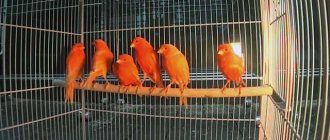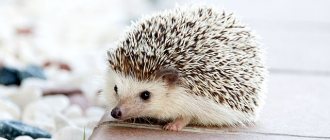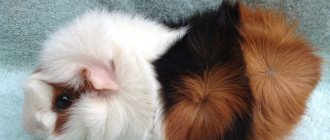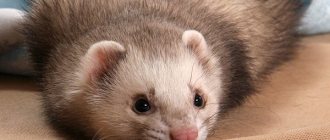Lemur: description, structure, characteristics. What does a lemur look like?
Lemurs are mammals and belong to the order of primates, the suborder of wet-nosed monkeys and the information group of lemurs themselves or lemuriformes. The closest relatives of lemurs are monkeys, although lemurs have many differences with them. As for the lemurs themselves, their entire family is divided into 5 subfamilies, numbering as many as 101 species of different lemurs. We will definitely describe the most interesting of them in this article.
The size of a lemur depends on its species; the smallest dwarf mouse lemur easily fits in a human palm. Its size is 18-22 cm in length including the tail (if measured without the tail, then only 9-11 cm) with a weight of 24-38 grams.
The largest lemur, the short-tailed indri, is 50-70 cm in length. The average weight of a lemur of this species is 6-8 kg.
An interesting fact: zoologists believe that once upon a time, both in Madagascar and on the African continent, there were truly gigantic lemurs weighing up to 200 kg. They were larger than modern gorillas. Unfortunately, these giant lemurs became extinct before they survived to our times.
The lemur's body is elongated and dense, its head is round and slightly flattened. The lemur's muzzle is somewhat similar to a fox's, just as elongated and pointed. Also on the muzzle there are antennae, which nature gave them not only for beauty, they perform the function of touch.
The lemur's eyes are unusually large, yellow or orange in color (however, there is also a species of blue-eyed lemur in nature - Sclater's black lemur). Sometimes lemur eyes look like saucers, the expression of their eyes often speaks of simultaneous amazement and fear.
The lemur's teeth have a special structure: on the upper jaw the incisors are spaced very widely, while on the lower jaw they are very close to the fangs and are at a significant inclination forward, thus creating a kind of “tooth comb”.
All four paws of the lemur have 5 toes, the thumb is opposite the others. In general, the structure of the paws of lemurs is very similar to that of monkeys and, of course, us humans: lemurs have nails on their fingers, and the nail of the lemur’s index finger is especially long, since lemurs use it for hygienic purposes, it is called “toilet.”
The lemur's tail is especially long, bushy and luxurious. The length of the tail is often equal to the length of the body, and sometimes even exceeds it. Lemurs have a tail not only for beauty, but also with its help they communicate with each other, and like squirrels, the tail helps them maintain balance when jumping from branch to branch.
But the species of lemur - the short-tailed indri, alas, cannot boast of its long tail; it has the shortest tail in the lemur family - it is only 3-5 cm in length.
The lemur's fur is thick and can have a wide variety of colors: some types of lemurs have gray-brown colors, others are black and white, and others have red or red-brown fur. The ring-tailed lemur has a funny coloration, whose long tail is decorated with black and white stripes.
Description of representatives of the lemur family
Primates have a dense and long body, the size of the head is small, with a rounded or flattened shape. The muzzle resembles a fox, it is pointed and elongated. Animals have 4 or 5 groups of vibrissae, which they need for touch.
Those around him are captivated by the lemur’s large eyes, close-set and saucer-like. They showed a wary expression of curiosity.Nocturnal primates have wider eye orbits than diurnal primates. The eyes of animals can be different, even a blue-eyed lemur is found.
The animal lemur has widely spaced incisors and lower incisors adjacent to the fangs. All limbs have 5 fingers on which nails grow. But there are some exceptions - there is a long claw on the second toe.
The Madagascar monkey does not have this characteristic. Lemurs need their nails to comb their fur.
As for the Madagascar bat, the fingers of its limbs are equipped with claws, and its nails are located only on the big toes.An attractive feature of primates is their gorgeous tail. It can be longer than the body.
Lemurs communicate with each other using their tail. It allows animals to maintain balance when they jump from one branch to another. The short-tailed indri has the smallest tail, its length is only 3-5 cm.
Coat color varies, with individuals having red fur or bright white fur.
There are species with a protective gray-brown color.
Particularly noteworthy is the ring-tailed lemur - its tail, curved in a spiral, is decorated with wide stripes of black and white.
- Detailed description with photos of all animals included in the Red Book of Russia
Zebra - habitats, appearance, diet and behavior, life cycle + 94 photos
Leopard - habitats, life cycle, rutting season and lifespan + 118 photos
Where do lemurs live?
In the old days, the ancestors of modern lemurs lived in Africa and on nearby islands, but only the lemurs of the island of Madagascar have survived to this day. Also, in natural conditions, lemurs live on the Comoros Islands neighboring Madagascar. And, of course, many lemurs were exported from Madagascar, and now they can be found in zoos around the world. These animals take root well and reproduce in captivity.
As for the island of Madagascar itself, the homeland of lemurs, they have mastered all the natural biotopes of the island. They can be found in the Madagascar jungle in the east of the island and in the temperate maritime climate of the central regions and in the arid forests of western Madagascar.
Can a primate live in captivity?
These cute little primates also take root well at home. The domestic lemur lives in captivity up to 14-15 years.
The small slow loris is the best one to settle into the house. These animals are affectionate, neat, easy to tame and even know some commands.
It is necessary to purchase a lemur only in special nurseries. In order for the animal to feel comfortable, it should install a large enclosure in a separate room, otherwise the lemur will be frightened by sharp sounds and strangers. It is also necessary to exclude drafts in the room.
Lemur lifestyle
Lemurs spend most of their lives in trees, which they climb very well, jumping from branch to branch, balancing their tails. However, there are also species of lemurs, such as the ring-tailed lemur, that spend a lot of time on the ground.
Lemurs, as a rule, lie on trees, basking in the Sun, where they make their lairs from branches, rest, and breed their offspring. If necessary, lemurs are able to cover long distances by jumping from branch to branch. For example, the jump of the Verreaux sifaka lemur is 9-10 meters.
Lemurs are social animals with a strong territorial sense. They live in family groups of 3 to 20-30 individuals. Within such a lemur group there is a strict hierarchy, the leader is the strongest female (yes, lemurs have matriarchy), who can choose males for herself to mate with during the mating season, and she also has an advantage when choosing food. The number of females and males in such a group is approximately equal, but if the females remain in the group until the end of their days, then the males sometimes go to other groups or may even begin to lead a solitary lifestyle.
Each group of lemurs has its own strictly defined territory, the area of which can range from 6 to 80 hectares. Lemurs mark the borders of their “kingdom” with a special secretion and urine, so that the alien lemurs can smell that there is nothing for them to do here.
Being social animals, lemurs actively communicate with each other using grunting or purring sounds, and sometimes they even scream. Additionally, lemurs communicate using their long tails.
An interesting fact: some species of lemurs, such as the dwarf lemur, fall into a kind of hibernation during the dry season - they sit in a daze on the branches, eat nothing at all, and at this time their body uses up pre-stored fat reserves.
Lemur diet
Lemurs' favorite food is plant-based. Since animals spend most of the day in trees, their daily diet consists of ripe fruits, young juicy shoots, sweet flowers, and sometimes bark and seeds.
To replenish their strength after seasonal hibernation, many species of lemurs use protein food - small insects, beetles, larvae, butterflies, and spiders.
Experts recommend feeding domestic lemurs with milk porridge, vegetables, sweet fruits, and boiled chicken eggs.
Almost all species of animals are in a threatening situation and are therefore listed in the Red Book. The main threat to lemurs is that the relict forest on the islands where they prefer to live is being destroyed.
What do lemurs eat?
Lemurs, like monkeys, are omnivores, but they are still much more vegetarian than carnivores. Their main diet is:
tree leaves, ripe fruits (lemurs especially love figs and bananas), plant shoots, seeds, tree bark. But sometimes various small animals can become prey for lemurs; usually lemurs eat various large insects: mantises, moths, crickets, spiders, cockroaches.
Some lemurs can hunt arboreal
frogs, lizards, and also eat small birds and their eggs.
Many lemurs eat like monkeys and humans, first taking food with their paws and then putting it in their mouth.
Enemies of lemurs
Despite their agility, lemurs often become prey to various large predators. The greatest threat to them is the Madagascar long-eared owl and barn owl, as well as
hawks. They are also attacked by snakes (especially the Madagascar tree boa) and some predatory mammals (narrow-striped mano, mongooses and even domestic dogs).
But be that as it may, lemurs suffer the most due to the destructive activities of humans. It has gotten to the point that now lemurs in Madagascar have officially been given protected status, since many of their species are on the verge of extinction. The intensive deforestation of Madagascar's tropical forests, the traditional habitats of these animals, has had a particularly detrimental effect on lemurs.
Conditions of detention
A tamed wild animal requires special conditions for normal development and growth, one of which is a climate appropriate to its natural habitat, as well as reliable and quiet housing.
At home, it is now increasingly common to keep exotic animals rather than cats and dogs: raccoon, crocodile, chamaleon, iguana, leopard gecko, squirrels, jerboas, mini-pigs, snails.
Climate in the apartment
Since the ancestors of this animal come from hot countries, the lemur is a heat-loving animal that is very easy to catch a cold. He is very afraid of drafts, cold, sudden changes in temperature and air humidity levels.
Lemur cage
A small enclosure or a large vertical cage with metal or wooden rods is ideal as a habitat for a lemur. In any case, the size of the housing is adjusted to the size of the animal. This is a very active and freedom-loving animal that needs a lot of space. There should not be any indoor plants near the cage, otherwise your friend may reach out to them and try them out of curiosity, and this can lead not only to a deterioration in the condition of the plant, but also to poisoning of the animal. Wires and ropes nearby also need to be removed, because this animal is very inquisitive, and the cage must be locked.
The bottom is covered with soft natural cotton wool or dried hay; the cage must also have some kind of shelter and tree branches, because the lemur is a nocturnal arboreal animal. A small wooden house, suspended on top of the cage, will become a good shelter at night, where he can climb using special “branches”, poles or crossbars, built separately and attached to the housing.
Important! An arboreal animal will leave marks on the wooden parts of its habitat; it is not recommended to wash them off: the animal may become frightened and experience stress.
Dishes for food and water should be made of ceramics, glass or porcelain.
Types of lemurs, photos and names
As we wrote above, zoologists have currently counted 101 species of lemurs, which make up 5 large families. Next, we will describe in detail the main families of lemurs and their most interesting species.
Family Arupodaceae
Madagascar bat
This species of lemur is the only representative of the family of bats. It is nocturnal and is the largest among nocturnal lemurs. The length of the Madagascar arm is 30-40 cm, with a weight of 2.4-2.8 kg. The fluffy tail of this lemur grows even larger than the body, its length is 45-55 cm. The body of the Madagascar lemur is covered with black-brown hair and dense undercoat.
Also, the Madagascar monkey has a round head, a short and wide muzzle, orange or yellow eyes and large ears, somewhat reminiscent of spoons in their shape. A characteristic difference between the hand-footed lemur and other lemurs is the fact that its thumb on its paws is practically not opposed to the rest. Another difference of this species is the absence of fangs, which is why zoologists even at first mistakenly classified the bat as a rodent, and only later found out that this is a specific variety of lemurs, which has deviated somewhat from the main group in the course of evolution. At the moment, the Madagascar monkey is listed in
Red Book.
Family of dwarf lemurs
This family includes the smallest representatives of the kingdom of lemurs, whose size resembles mice or rats. Although in their lifestyle, dwarf lemurs are more similar to
squirrels, they also live in the crowns of trees, jumping on branches.
Dwarf mouse lemur
This is the smallest lemur in the world and one of the smallest primates (only the pygmy marmoset, a small monkey, is smaller than it). In its size and appearance it resembles a large mouse, its length is 18-22 cm, with a weight of 24-38 grams. It has a reddish-brown coat color on the back and a creamy white belly. The eyes of the dwarf mouse lemur are surrounded by dark rings and therefore appear especially large.
Rat lemur
Another representative of the dwarf lemur family. In size, the rat lemur is slightly larger than its mouse relative; its body length is 20-25 cm and weighs up to 140 grams. The large eyes of this lemur are equipped with a special choroid - tapetum, thanks to which these animals are able to see perfectly in the dark (such a built-in biological night vision device). The gray or red-brown color of their fur is somewhat reminiscent of a rat's, hence the name of this species.
Family of lepilemurids or slender-bodied lemurs
This includes medium-sized lemurs, with a body length of about 30 cm and a weight of about 1 kg.
Northern slender-bodied lemur
It is one of the smallest representatives of the family of slender-bodied lemurs, its body length is 28 cm, weight – 700-800 grams. It differs from other lemurs in its small ears and completely vegetarian lifestyle; these lemurs eat exclusively plant foods.
Small-toothed lemur
This lemur differs from other fellows in that it leads a solitary lifestyle. He is also a true vegetarian. The body length of the small-toothed lemur is 25-29 cm, weight - 0.9-1.2 kg.
Lemur family
It includes the most famous and well-studied species of lemurs.
Ring-tailed lemur
He is also the ring-tailed lemur, he is also the catta lemur, he is also the common lemur - one of the most striking representatives of the lemur family. Its size is similar to
cat, the body length of the ring-tailed lemur is 39-46 cm, with a weight of 2.3-3.5 kg. At the same time, their luxurious striped black and white tail is larger than the body; the length of the tail of this lemur is 56-63 cm.
An interesting fact is that with the help of their tails, male ring-tailed lemurs sometimes sort things out, smear the tail into a special odorous secretion under the armpits, then poke each other with their tails; the stronger the smell coming from the tail, the higher its owner will have a position in the lemur hierarchy.
Also, although these lemurs are excellent at climbing trees, they prefer to walk on the ground, and more than all their other relatives spend time not in the trees, but below.
Black lemur
He's a macaque lemur. Another representative of the lemur family, it is distinguished by its rather large size, its length is 38-45 cm and its weight is 2-3 kg. Like the ring-tailed lemur, it has a very long tail, 51-64 cm long. The fur of the black lemur, surprisingly, is also completely black, although in daylight you can see reddish-brown shades.
Brown lemur
Another representative of the lemur family, also quite large. Its body length is 38-50 cm, with a weight of 1.9-4.2 kg. It has a brown or gray-brown coat color. In addition, its head and muzzle have a more intense black and gray color.
Blue-eyed lemur
He's Sclater's black lemur. The main difference between this lemur is its blue eyes, which are uncharacteristic of other relatives. The blue-eyed lemur is a close relative of the black lemur, as evidenced by the black coat of its males. Females are red-brown in color. The body length of this lemur is 39-45 cm, weight – 1.8-1.9 kg. And of course there is a huge long tail.
Lemur Vari
This lemur is the largest among the lemur family (but not among all lemurs), its body length is 51-56 cm, weight 3-4.5 kg. The thick and fluffy fur of this lemur is colored black and white.
Red Varya
A close relative of the lemur Vari, it is slightly inferior in size; the length of the red Vari is 40-50 cm, with a weight of 3-4 kg. The back of this lemur is red in color, while the belly and head are black. And the red-haired Vari is unusually fertile even for other lemurs; their females give birth to 5-6 cubs, while other lemurs give birth to no more than 2-3.
Indriaceae family
A distinctive feature of lemurs from the Indriidae family is their muzzle, which is completely devoid of hair.
Indri
He is also a short-tailed indri, aka babakoto (as the local Malagasy people call him) - the largest lemur in the world. Its size is 50-70 cm, weight – 6-7.5 kg. Having the largest size among lemurs, the indri's tail, on the contrary, is the smallest, its length is 4-5 cm. Although the indri's muzzle is devoid of hair, its ears are quite large and shaggy. The indri coat color is a combination of black, white and gray.
Sifaka Verro
He is also a crested sifaka, he is also a crested indri. A fairly large lemur, its body length is 42-45 cm, weight 3.4-3.6 kg (males are usually larger than females). It also has a large and fluffy tail. These lemurs are interesting because they can move vertically on their hind legs. It has a white coat with black areas on the head, sides and forelimbs.
Among primates there are species that differ from the order. One of these are lemurs.
2. This species of primate is the least similar to humans.
3. The closest relatives of lemurs are lorises. About 60-80 million years ago they evolved from a common ancestor when the branches of evolution split.
4. Lemurs live only on the Comoros Islands and Madagascar - you won’t find them anywhere else on Earth.
5. Previously, there were 60 species of lemurs, but since 2008, 93 species of lemurs are known. All species are divided into 6 families. Lemurs of each species differ in their size, slightly in structure and, of course, in color.
6. The main types of lemurs: graceful, fat-tailed, dwarf, squirrel, gray, collared, black, mongoose and ring-tailed.
Indri lemur
7. The largest species of lemur is the indri. These animals weigh about 10 kilograms with a body length of up to 90 centimeters, but they have the shortest tails - usually no longer than 5-6 centimeters.
8. The morning singing of indri lemurs, with which they indicate their rights to the territory they occupy, can be heard at a distance of up to 2 kilometers.
9. Indri, unlike other types of lemurs, cannot live in captivity, so breeding them in an artificial environment is impossible.
10. Lemurs' tails are longer than their bodies; in some species the tail length exceeds 50 centimeters.
Dwarf lemur
11. Dwarf lemurs, also known as mouse lemurs, are the smallest primates on Earth. They weigh no more than 30 grams, and the length of their body without a tail does not exceed 10 centimeters.
12. Giant lemurs used to live on Earth, but they became extinct long ago.
Ring-tailed lemur
13. Lemurs are mainly nocturnal animals with large and round eyes.
14. Lemurs live mainly in trees, and they can also move through trees. Only a few species live on land.
15. From Latin the word “Lemur” means ghost of the night.
Blue-eyed lemur
16. Blue-eyed lemurs are the only primates other than humans whose eyes are actually blue.
17.They live exclusively on the island of Madagascar. Thanks to the fact that higher primates did not reach this island, lemurs are still alive.
18. Lemurs can instantly go from a state of relaxed bliss to a state where they are ready to run and escape from any danger.
19. Some species of lemurs use the earth as an antidote to poisonous substances contained in the leaves of some trees.
20. The speech of lemurs is rather poor. To communicate with their relatives, they use only 12 sounds, similar to either grunting or purring.
Fat-tailed lemur
21. Fat-tailed lemurs are the only primates in the world that can hibernate.
22. Fat-tailed lemurs accumulate fat reserves in their tail, sometimes doubling their mass, and during hibernation their body temperature can range from +10 to +40 degrees depending on environmental conditions.
23. In the distant past, lemurs moved from continental Africa to Madagascar on wooden rafts, seeking refuge from predators.
24. In some species of lemurs, the length of the tail exceeds the length of the body.
25. With the help of their tail, lemurs are able to control the direction of the flow of smells. This helps them communicate.
26. Indri lemurs live in humid forests, but they are also found at altitudes of up to 1.8 kilometers above sea level.
27. At such an altitude, even a person who is not accustomed to low blood pressure usually already feels unwell.
28. In ancient Rome, it was believed that lemurs are the souls of dead people who cannot find peace.
29. Since lemurs are nocturnal primates, they feed and stay awake at night, and during the day they sleep in trees or in shelters that they themselves build or find.
30. If necessary, lemurs can hibernate for a long time, while their body temperature is compared with the ambient temperature. Almost no other mammal is capable of this.
Madagascar lemurs
31. There are so many different lemurs in the relatively small Madagascar because this island was inaccessible to other primates for a long time. In this isolation and relative safety during evolution, these animals occupied all the ecological niches that primates could occupy.
32. The population of Madagascar is afraid of lemurs. People think that if they kill a lemur, they will be cursed and die within a year.
33. Demonstrating their affection, lemurs sort through the fur of the object of their adoration with the help of their teeth.
34. Unfortunately, the local inhabitants of the island of Madagascar, the Malagasy, consider the Madagascar bats to be helpers of evil spirits, so these animals are constantly hunted.
35. Lemurs’ favorite food is dates; these fruits can make up up to half of the animals’ annual diet.
36. Lemurs live in very friendly families from 3 individuals to 25-30. Females dominate families, choosing what to eat and who to mate with.
37. The family marks their kingdom with urea; the territory in their possession can be up to 80 hectares of land.
Baby lemurs
38. About half of lemur cubs die in the first year of their lives - they are usually born, unfortunately, rather weak.
39. Female lemurs usually carry their babies in their mouths. When they grow up, they begin to travel riding on their mother's back, clinging to the wool.
40. Cautious and timid by nature, they, however, can gradually get used to a person and begin to trust him. True, this will take a lot of time.
41. Lemurs are often endangered by predators. They are hunted by snakes, hawks, owls, mungos, fossas and dogs.
42.On average, 25% of lemurs become their victims every year. But this does not interfere with the population, as they multiply quickly.
Fossa hunts lemurs
43. Depending on the species, lemurs feed on bananas, leaves, flowers, seeds, and dates.
44.They also eat insects such as beetles, butterflies, mantises, crickets, cockroaches and spiders. The gray lemur even eats frogs, lizards and chameleons. When there is no adequate nutrition, they can even eat rotten tree bark.
45. Lemurs are not picky about food, and when they get into captivity, they quickly get used to the diet that is provided to them.
46. Lemurs spend most of their lives in trees.
47. In the trees, lemurs behave very dexterously, but once on the ground, they move by jumping, raising their front legs.
48. Lemurs are primates that easily get used to changes in housing and lifestyle.
49. The average lifespan of lemurs is about 25-27 years.
50. Living in large groups, lemurs are truly unique; they are unlike any other animal.
photo from the Internet
Lemur breeding
The mating season for each species of lemur is strictly defined and is usually confined to a specific season. For example, dwarf lemurs breed from December to May, and indrius lemurs only during the spring.
Also, lemurs reach sexual maturity in different ways; dwarf lemurs become sexually mature at 1.5 years, while indri lemurs mature only at 4-5 years.
Mating flirtations among lemurs manifest themselves in the form of loud screams and touches. And as we wrote above, many lemurs are dominated by matriarchy, which means that females can choose suitable males for procreation.
Also, indri lemurs usually form strong monogamous pairs; only in the event of the death of one of the partners can the male or female look for a new pair. But other types of lemurs are not so faithful; they usually lead a polygamous lifestyle.
Pregnancy lasts different times for different lemurs, averaging from 2 to 5 months. Also, all types of lemurs, with the exception of bats, usually give birth once a year. As for the arms, they are slower in this regard and bear offspring no more than once every 2-3 years. Usually 1-3 cubs are born at a time, and only the more fertile lemurs have 4 to 6 small babies.
Lemurs, like kittens, are born blind, but regain their sight on the second day of life. Newborn dwarf lemurs weigh 3-5 grams, while little lemurs of larger species weigh between 80 and 120 grams at birth. As soon as they are born, newborn citizens of the lemur family hang on their mother’s belly, clutching her fur with tenacious hands. Some lemurs carry their babies in their mouths, and baby dwarf lemurs spend the first 2-3 weeks of their lives in secluded nests or tree hollows. But the cubs of ring-tailed lemurs and common lemurs have the habit of climbing onto their mother’s back.
During the first months of their life, little lemurs are under the constant care of their mother, and in monogamous indri lemurs, they are under the constant care of their father. Breastfeeding with mother's milk lasts 4-5 months. After this period ends, lemurs begin to grow rapidly and soon become fully grown.
What are lemurs like?
Lemurs were classified in 1766 by the French naturalist Buffon. These animals belong to the genus of prosimians and are divided into three main species and several subspecies. They are divided into:
- slender loris;
- slow loris;
- pygmy loris.
The largest representatives of lemurs weigh only 1.6 kg, and individuals of the dwarf species weigh 300 grams. Body sizes can be from 20 to 40 cm depending on the species. Their fur has a short pile that fits tightly to the body, color variations range from yellowish to brown, the fur on the abdomen is noticeably lighter, and a dark stripe runs down the back. These animals have miniature, rounded ears, and the tail is almost invisible.
Lemur at home: maintenance and care
Sometimes lovers of exotic pets get a pet lemur. And why not, many species of lemurs (but not all) are easily tamed by humans, they are not aggressive and docile. But before you get yourself such a Madagascar pet, you need to know the nuances of caring for a lemur, and how to feed it correctly.
It is very important that the cage or terrarium in which the lemur will live is spacious; you must place tree branches there and hang artificial vines on which the pet will climb, remembering its native Madagascar forests. The bottom of the cage should contain sawdust; they will have to be changed periodically, since it will not be possible to train a lemur to a tray. If you don’t clean it regularly, then both the cage and the lemur itself will soon begin to smell very bad, you know what. Also, there should always be a bowl of drinking water in the cage so that the lemur can quench his thirst at any time.
Although lemurs are protected by fur, nevertheless, being heat-loving animals, they do not tolerate drafts well, so the cage with the lemur should be in a place protected from drafts.
House for the lemur
Initially, everything depends on the size of the resident; the larger the lemur, the larger the cage it needs. Wooden or metal rods - it doesn’t matter, you can even choose a cage of a mixed type, the animal will not pay attention to this.
It is necessary to arrange a nest in the cage, for example, made from an old hat, or even build a wooden house. Bedding in the enclosure is also required; it can be made from hay or cotton wool.
Home hygiene
Remember that it is impossible to toilet train a lemur; if you let it out for a walk around the apartment, it will not return to the cage to do its business. Therefore, you will have to clean the cage daily and change the bedding at least once a month. The floor also needs to be washed monthly, simply wiping with a damp cloth without special chemicals.
Even if the door in the enclosure is very large, and your love for lemurs is enormous, you cannot reach the animal with your hands. Lemurs are very afraid of such attacks from humans and can easily bite. To get the animal you need to use a net.
What to feed a lemur at home
Since lemurs are crepuscular and nocturnal animals, they should always be fed in the evening and at night. During the day, a lemur may well refuse food and this is normal for them. As for the foods that the lemur eats, this includes a variety of plant and animal foods:
Occasionally, lemurs can be given milk and even kefir, but only in small quantities. Since lemurs in natural conditions eat small insects, you can also purchase live crickets, cockroaches or mealworms for your pet lemur at a specialized zoological store, which they will happily eat.
Lemurs also have a sweet tooth and sometimes you can pamper them with boiled dried fruits, nuts and honey.
Home maintenance
For the first time, while the baby gets used to the new home, he will spend all his time in the cage, so choose a spacious cage with several hiding places. The ideal option is an aviary.
Lemur in a cage
The material does not matter - the rods can be metal, plastic or wood. The cage should have separate bowls for food and water, also made of any material. The water must be changed regularly, a couple of times a day.
In the cage itself, it is advisable to recreate a natural landscape - branches, small trees, you can make a nest on a tree (for example, an old earflap hat), but it is better to have a closed house where the animal will hide. But you can’t clutter it up, lemurs have bursts of energy, they start running and jumping very actively, and there should be enough spacious space.
Once a month it is necessary to carry out general cleaning, wiping everything with a damp cloth. But natural waste products will have to be removed every day, and more than once.
It is best to place the cage in a calm, quiet place where there are no drafts, heaters, or direct sunlight. It is also recommended to purchase a weak UV lamp, which you can turn on during the day for a couple of hours.
Of course, when the baby gets comfortable and stops being afraid, you can let him walk around the apartment, gradually accustoming him to holding hands. The loris does not get along with other domestic animals and is also wary of children.
Diet
Lemurs feed on both plant and animal foods:
- Insects;
- Chicken fillet;
- Porridge;
- Dairy products;
- Vegetables fruits;
- Mealworms;
- Chicken eggs;
- Bread.
If the lemur refuses to eat, then coat the food with honey, they adore it.
Lemur eats a grasshopper
For balance, you need to adhere to the rule - a third of the diet is insects, a third is porridge and sour milk, and a third is vegetables and fruits. If there is too little or too much of some food, the lemur will get sick.
By the way, insects can be frozen in the freezer in the summer, thereby saving them for future use throughout the winter.
You shouldn’t offer them food from our table; allergies or intestinal disorders are possible.
Try to feed it by hand, thereby establishing contact so that the animal does not see you as a threat.
And remember - we are responsible for those we have tamed!
Interesting facts about lemurs
- Residents of Madagascar, the Malagasy, have long believed that lemurs are the souls of their dead ancestors, so in some villages residents even bring them special fruit offerings.
- But another funny Malagasy superstition did not benefit the lemurs: it is believed that the dried index finger of a lemur can restore... lost male potency. Therefore, sometimes lemurs became the subject of hunting by elderly Malagasy people who wanted to again feel like 19-year-old boys in amorous affairs.
- Malagasy people have a special superstitious fear of the lemur. According to the islanders, any person who kills a little hand will die within a year. Scientists still do not know what the locals call the little hand, since they never say its name out loud.
- The vocal range of lemurs has 12 different sounds. With their help, these animals communicate with each other, and what’s interesting is that some of these sounds sound at the ultrasound level.











